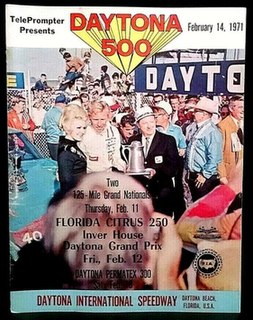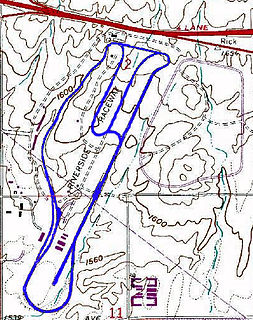Related Research Articles

The 1971 Daytona 500, the 13th running of the event, was a NASCAR Winston Cup Series race held on February 14, 1971 at Daytona International Speedway in Daytona Beach, Florida. Spanning 500 miles (800 km) on the paved oval track, it was the first Daytona 500 in the Winston Cup era of NASCAR. During this time, Richard Petty was becoming one of the winningest veterans on the NASCAR circuit.

The 1971 Motor Trend 500 was the first race in NASCAR's Winston Cup era that took place on January 10, 1971. 191 laps on a road course at Riverside International Raceway in Riverside, California that spanned a total distance of 2.620 miles (4.216 km).
The 1971 Islip 250 was a NASCAR Winston Cup Series race that was conducted on July 15, 1971, at Islip Speedway in Islip, New York

The 1971 Delaware 500 was a NASCAR Winston Cup Series race that took place on October 17, 1971, at Dover Downs International Speedway.
The 1970 Georgia 500 was a NASCAR Grand National Series event that was held on November 8, 1970, at Middle Georgia Raceway in Byron, Georgia.

The 1969 National 500 was a NASCAR Grand National Series stock car race that was held on October 12, 1969, at Charlotte Motor Speedway in Concord, North Carolina. This race is still being held in today's Monster Energy NASCAR Cup Series as the 'Bank of America 500'.
The 1970 Greenville 200 was a NASCAR Grand National Series event that was held on June 27, 1970, at Greenville-Pickens Speedway in Greenville, South Carolina.
The 1971 Myers Brothers 250 was a NASCAR Winston Cup Series event that took place on August 6, 1971, at Bowman Gray Stadium in Winston-Salem, North Carolina. This race was the final NASCAR Cup Series event at Bowman Gray Stadium.

The 1973 Gwyn Staley 400 was a NASCAR NASCAR Cup Series racing event that took place at North Wilkesboro Speedway on April 8, 1973, in North Wilkesboro, North Carolina.

The 1972 Texas 500 was a NASCAR Winston Cup Series racing event that took place on November 12, 1972, at Texas World Speedway in College Station, Texas.

The 1972 Carolina 500 was a NASCAR Winston Cup Series racing event that took place on March 12, 1972, at North Carolina Motor Speedway in Rockingham, North Carolina.

The 1972 Old Dominion 500 was a NASCAR Winston Cup Series racing event that was held on September 24, 1972, at Martinsville Speedway in Martinsville, Virginia.

The 1973 Tuborg 400 was a NASCAR Winston Cup Series race that took place on June 17, 1973, at Riverside International Raceway in Riverside, California.

The 1980 Richmond 400 was a NASCAR Winston Cup Series racing event that took place on February 24, 1980, at Richmond Fairgrounds Raceway in Richmond, Virginia.

The 1972 Northern 300 was a NASCAR Winston Cup Series racing event that took place on July 16, 1972, at Trenton Speedway in Trenton, New Jersey.

The 1971 Volunteer 500 was a NASCAR Winston Cup Series racing event that took place on July 11, 1971, at Bristol Motor Speedway in Bristol, Tennessee.

The 1971 National 500 was a NASCAR Winston Cup Series racing event that took place on October 10, 1971, at Charlotte Motor Speedway in Concord, North Carolina. Most of the vehicles used in the race had a rating of 427 cubic inches.
The 1971 Asheville 300 was a NASCAR Winston Cup Series racing event that took place on May 21, 1971, at New Asheville Speedway in Asheville, North Carolina.
The 1971 Kingsport 300 was a NASCAR Winston Cup Series racing event that took place on May 23, 1971, at Kingsport Speedway in Kingsport, Tennessee.

The 1970 Rebel 400 was a NASCAR Grand National Series event that was held on May 9, 1970, at Darlington Raceway in Darlington, South Carolina. The race is known for a crash involving Richard Petty that inspired NASCAR to implement the window net; a mandatory safety feature in today's NASCAR vehicles.
References
- ↑ "1971 West Virginia 500 weather information". The Old Farmers' Almanac. Retrieved 2012-06-12.
- 1 2 3 4 5 6 7 8 9 10 11 12 13 "1971 West Virginia 500 information". Racing Reference. Retrieved 2010-12-05.
- 1 2 3 4 5 6 "1971 West Virginia 500 information (second reference)". Ultimate Racing History. Retrieved 2010-12-05.
- 1 2 3 "1971 West Virginia 500 information (third reference)". Everything Stock Car. Archived from the original on 2011-07-10. Retrieved 2010-12-06.
- ↑ "Petty Laps Allison To Win West Virginia 500". West Virginia Culture. Retrieved 2018-09-24.
- ↑ "1971 West Virginia 500 crew chiefs". Racing Reference. Retrieved 2018-08-21.